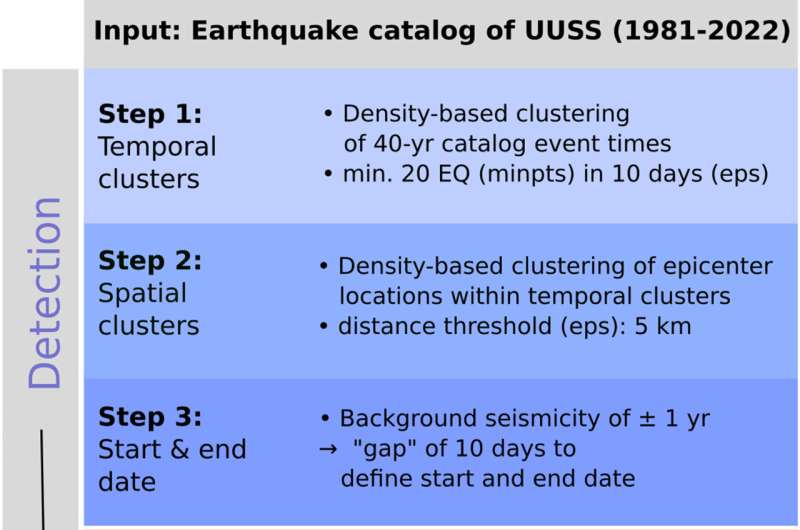This article has been reviewed according to Science X's editorial process and policies. Editors have highlighted the following attributes while ensuring the content's credibility:
fact-checked
trusted source
proofread
What can central Utah's earthquake 'swarms' reveal about the West's seismicity?

Most of the earthquakes rumbling under the West's Great Basin come in surges, clustered together in time and place. Scientists call these seismic groups "swarms," which are a distinct category from the numerous aftershocks following a big shake, such as the 5.7 magnitude Magna quake of 2020 on the Wasatch Fault.
Rather than getting spread out evenly over time, many of these small, often imperceptible quakes strike a region in a short period of time, say a few days or weeks.
Central Utah has been the stage for dozens of earthquake swarms that have been recorded over the past 40 years by an ever-expanding network of seismic arrays managed by the University of Utah.
Now Utah seismologists are analyzing decades of seismic data in hopes of discerning the significance of these swarms in a geologically complex region known as a geothermal hotspot and for recent—geologically speaking—volcanism.
"In central Utah, seismic swarms are much more common than any other type of sequence. We looked into all types of sequences, but 80% of the sequences are swarms. That's remarkable," said Gesa Petersen, a post-doctoral research fellow. "We also saw that these are very heterogeneous. So one location in central Utah can have a very, very different behavior than other locations just 30, 40, 50 kilometers away."
The findings were published July 13 in the journal Geochemistry, Geophysics, Geosystems.
A geothermal hot spot
Located outside Milford, FORGE is within the research area that spans Beaver, Iron, Sevier and Paiute counties. The research area is home to three geothermal power-generating plants and includes the towns of Circleville, Beaver and Richfield.
The researchers suspect the earthquakes are triggered by hot water, powered by geothermal activity, coursing through fissures in Earth's crust.
During the past 40 years, the University of Utah Seismograph Stations detected earthquake sequences featuring earthquakes of magnitude 1.5 or greater. But in further examining the data, Peterson and Pankow were able to identify hundreds of additional smaller earthquakes, as small as magnitude 0.5 recorded in 50 distinct sequences.
They concluded 40 qualified as swarms. Much can be learned from these smaller quakes, but they are hard to study, according to Pankow, who is the Seismograph Stations associate director.
"We're all worried about the Wasatch Front, but the other thing to know is we have earthquakes all over Utah," said Pankow. "We recorded a certain level, but in some of these places there's probably earthquakes happening all the time that we just don't see. That's something that's really important to get an understanding of."
Thousands of earthquakes
All told the research analyzed 2,300 earthquakes, most of which were between magnitude 1 and 3. The largest was a magnitude 5.1 that hit east of Richfield in 1989. That one was not part of a swarm, but rather was a mainshock followed by numerous aftershocks. The full catalog for the study area contains 20,000 events between 1981 and 2023, according to Petersen.
"However, we cannot exactly say how many of them are part of a sequence because we limit the study for sequences that have at least 20 earthquakes within 10 days. We do not look into smaller sequences because we need some minimum to look at statistical parameters and to compare characteristic patterns of the sequences," she said.
"However, in the 1980s and 1990s, the seismic network of Utah was not as dense as today. There were significantly less stations. Therefore we can only study larger sequences with larger magnitudes from these times. There were likely many more swarms or seismic sequences."
The study greatly expanded on another recent study that focused exclusively on a swarm of hundreds of small quakes around Milford in the spring of 2021. That area had not experienced much earthquake activity during the entire 40-year window of seismograph data. Meanwhile, earthquakes have been happening as frequently as every few months in the nearby Mineral Mountains to the west during this same time period, Petersen said.
"So it's a very heterogeneous system there," she said. "You have a bunch of earthquakes in the same place and you can start learning about the structures that are activated in the place. If you have like only a single earthquake, you can't learn that much then."
The Mineral Mountains swarms were first detected a few years ago when new seismometers were installed for the FORGE geothermal research project.
"Before that we didn't have the resolution, but now we can see there are events always coming, and it's rapid," Petersen said. "Within a couple of hours, you suddenly have 30, 40, 50 events and then it's pausing again. You have this repeatedly, you have lots of activity. You can't really feel it. It's too small for that, but we can see it on the seismometers."
The paper is titled "Small-Magnitude Seismic Swarms in Central Utah (US): Interactions of Regional Tectonics, Local Structures and Hydrothermal Systems."
More information: G. M. Petersen et al, Small‐Magnitude Seismic Swarms in Central Utah (US): Interactions of Regional Tectonics, Local Structures and Hydrothermal Systems, Geochemistry, Geophysics, Geosystems (2023). DOI: 10.1029/2023GC010867
Provided by University of Utah



















